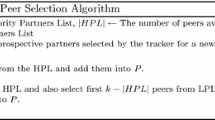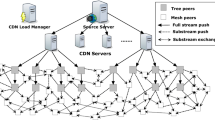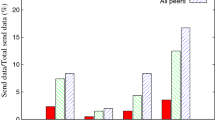Abstract
Due to the advantages of high scalability and low cost, P2P techniques have been known as a promising solution to a large-scale live streaming system. In the conventional P2P mesh-pull structure, however, a newly joined peer is more likely to connect to peers that have joined most recently and thus have relatively long playback lags. To reduce the average playback lag in a P2P live streaming system, we therefore propose an efficient scheme to select neighbor peers when a new peer joins. In our proposed scheme, even peers whose numbers of connectable neighbor peers have already reached the maximum can be selected as neighbor peers of a new peer through connection switching. Since this makes the playback range of the system denser, data duplication among peers increases considerably. In addition, to prevent the degradation of playback quality of the two peers whose connection is switched to a new peer from each other, connection switching is performed only when all of their neighbor peers have already buffered sufficient data. Through extensive simulations, we show that our proposed scheme reduces playback lag and startup latency significantly compared with the conventional policy.








Similar content being viewed by others
References
Agarwa V, Rejaie R (2005) Adaptive multisource streaming in heterogeneous peer-to-peer networks. In: Multimedia computing and networking conference, pp 13–25
Barekatain B, Khezrimotlagh D, Maarof M, Ghaeini H, Quintana A, Cabrera A (2015) Efficient P2P live video streaming over hybrid wmns using random network coding. Wirel Pers Commun J 80:1761–1789
Chang C, Chou C, Chen K, Chunk C (2014) Scheduling over swarm-based P2P live streaming system: from theoretical analysis to practical design. IEEE J Emerg Sel Top Circ Syst 4(1):57–69
Cui L, Jiang Y, Wu J (2011) Employing QOS driven neighbor selection for heterogeneous peer-to-peer streaming. In: IEEE conference on communications, pp 1–6
Ganesh A, Kermarrec A, Massoulie L (2001) Scamp: peer-to-peer lightweight membership service for large-scale group communication. In: Workshop on networked group communication, pp 44–55
Gau V, Wang Y, Hwang J (2008) A hierarchical push-pull scheme for peer-to-peer live streaming. In: IEEE symposium on circuits and systems, pp 2066–2069
Hei X, Liang C, Liang J, Liu Y, Ross K (2007a) A measurement study of a large-scale P2P IPTV system. IEEE Trans Multimed 9(8):1672–1687
Hei X, Liu Y, Ross K (2007b) Inferring network-wide quality in P2P live streaming systems. IEEE J Sel Areas Commun 25(9):1640–1654
Hei X, Liu Y, Ross K (2008) Iptv over P2P streaming networks: the mesh pull approach. IEEE Commun Mag 46(92):86–92
Hsu M, Hsiao T, Miao Y (2013) An adaptive approach to optimize tree-based overlay for P2P streaming. J Adv Comput Netw 1(1):18–21
Jia W, Liu G, Chen Y (2015) Nat-aware peer grouping and chunk scheduling for mesh-pull P2P live streaming systems. In: IEEE conference on computer software and applications, pp 387–392
Jo D, Helal S, Kim E, Lee W, Lee C (2011) Adaptive push-pull protocols for P2P-based video streaming. IEICE Trans Commun 94(10):2759–2762
Lee C, Kim S, K E (2015) Expediting P2P video delivery through a hybrid push–pull protocol. Adv Electr Comput Eng 15(4):3–8
Lehrieder F, Oechsner S, Hofeld T, Despotovic Z, Kellerer W, Michel M (2010) Can P2P-users benefit from locality-awareness? In: IEEE conference on peer-to-peer computing, pp 1–9
Li S, Zhao J, Xin W (2012) Elite: differentiating the playback lag for peer-assisted live video streaming. In: IEEE workshop on quality of service, pp 1–9
Li Z, Cao J, Chen G (2008) Continustreaming: achieving high playback continuity of gossip-based peer-to-peer streaming. In: IEEE conference on parallel and distributed processing, pp 1–12
Liao X, Jin H, Liu Y, Ni L (2007) Scalable live streaming service based on interoverlay optimization. IEEE Trans Parallel Distrib Syst 18(12):1663–1674
Magharei N, Rejaie R, Guo Y (2011) Incorporating contribution-awareness into mesh-based peer-to-peer streaming systems. Peer Peer Netw Appl Conf 4(3):231–250
Payberah A, Dowling J, Haridi S (2011) Glive: the gradient overlay as a market maker for mesh-based P2P live streaming. In: International symposium on parallel and distributed computing, pp 153–162
Piatek M, Krishnamurthy A, Venkataramani A, Yang R, Zhang D, Jaffe A (2010) Contracts: practical contribution incentives for P2P live streaming. In: USENIX symposium on networked systems design and implementation, pp 81–94
Picconi F, Massoulie L (2009) ISP friend or FOE? Making P2P live streaming ISP-aware. In: IEEE conference on distributed computing systems, pp 413–422
Sakata Y, Takayama K, Endo R, Shigeno H (2012) A chunk scheduling based on chunk diffusion ratio on P2P live streaming. In: IEEE conference on network-based information systems, pp 74–81
Shen Z, Zimmermann R (2009) ISP-friendly peer selection in P2P networks. In: ACM conference on multimedia, pp 869–872
Tan G, Jarvis S (2006) A payment-based incentive and service differentiation mechanism for peer-to-peer streaming broadcast. In: IEEE conference on international workshop on quality of service, pp 41–50
Tomozei D, Massoulie L (2010) Flow control for cost-efficient peer-to-peer streaming. In: IEEE INFOCOM proceedings conference, pp 1–9
Trajkovska I, Rodriguez P, Cervino J, Harsh P, Salvachua J (2014) P2p incentive model for QOS based streaming systems. In: IEEE conference on consumer communications and networking, pp 281–286
Tran H, Won Y, Kim J (2017) An efficient hybrid push-pull methodology for peer-to-peer video live streaming system on mobile broadcasting social media. Multimed Tools Appl 76(2):2557–2568
Tuan N, Li B, Eliassen F (2010) Chameleon: adaptive peer-to-peer streaming with network coding. In: IEEE INFOCOM conference, pp 1–9
Wang F, Xiong Y, Liu J (2007) Mtreebone: a hybrid tree/mesh overlay for application-layer live video multicast. In: IEEE conference on distributed computing systems, pp 49–56
Wang L, Zhang D, Yang H (2013a) QOS-awareness variable neighbor selection for mesh-based P2P live streaming system. In: IEEE conference on information science and technology, pp 1197–1201
Wang M, Li B (2007a) Lava: a reality check of network coding in peer-to-peer live streaming. In: IEEE conference on computer communications, pp 1082–1090
Wang M, Li B (2007b) R2: random push with random network coding in live peer-to-peer streaming. IEEE Sel Areas Commun 25(9):1655–1666
Wang P, Huang H, Xie C (2013b) A pre-buffer mechanism in multi-channel P2P live streaming. In: IEEE conference on networking, architecture and storage, pp 292–296
Wu H, Xu K, Zhou M, Wong A, Li J, Li Z (2013a) Multiple-tree topology construction scheme for P2P live streaming systems under flash crowds. In: IEEE conference on wireless communications and networking, pp 4576–4581
Wu W, Lui J, Ma R (2013b) On incentivizing upload capacity in P2P-VOD systems: design, analysis and evaluation. Comput Netw 57(7):1674–1688
Yang K, Wang B, Zhang Z (2013) A method of identifying P2P live streaming based on union features. In: IEEE conference on software engineering and service science, pp 426–429
Zhang M, Zhang Q, Sun L, Yang S (2007) Understanding the power of pull-based streaming protocol: can we do better? IEEE J Sel Areas Commun 25(9):1678–1694
Zhang M, Sun L, Xi X, Yang S (2008) Igridmedia: providing delay-guaranteed peer-to-peer live streaming service on internet. In: IEEE conference on global telecommunications, pp 1–5
Acknowledgements
This research was supported by Basic Science Research Program through the National Research Foundation of Korea(NRF) funded by the Ministry of Education (no. 2016R1D1A1A09917396) and the Ministry of Science, ICT & Future Planning (no. 2017R1A2B4010395).
Author information
Authors and Affiliations
Corresponding author
Ethics declarations
Conflict of interest
The authors declare that they have no conflict of interest.
Rights and permissions
About this article
Cite this article
Kim, E., Kim, J. & Lee, C. Efficient neighbor selection through connection switching for P2P live streaming. J Ambient Intell Human Comput 10, 1413–1423 (2019). https://doi.org/10.1007/s12652-018-0691-9
Received:
Accepted:
Published:
Issue Date:
DOI: https://doi.org/10.1007/s12652-018-0691-9




